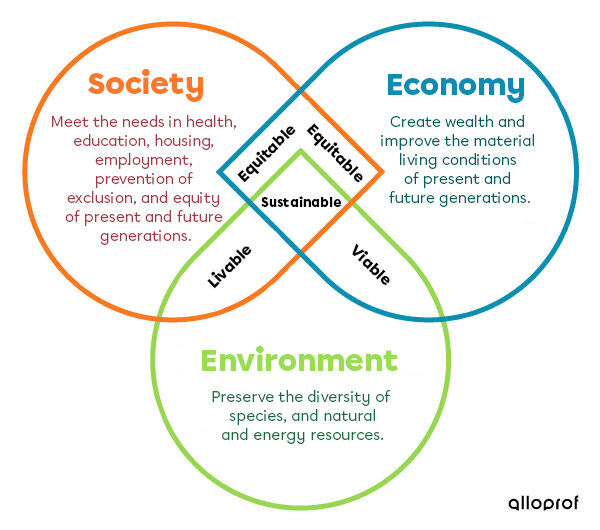In the past, humans considered the environment to be an inexhaustible resource for raw materials. In addition, it was believed that the Earth had its own mechanisms for absorbing the waste produced by human activity. Today, the global population is approximately 7 billion people. The sources of pollution are more numerous, not to mention the growing energy needs. The environmental issues exceed the territorial limits of Québec and even those of Canada: these issues are international in scope. This is why it is important to rely on the collaboration of several countries to find solutions.
The main environmental issues at present are the following.
Sustainable development is a concept put forward in the 1980s by the International Union for Conservation of Nature (IUCN).
This concept is defined as “development that meets the needs of the present without compromising the ability of future generations to fulfill their own needs.” Therefore, this is an important factor for sustainability. It is now time to realize that actions taken today can have serious consequences tomorrow.
Why promote such a concept?
The scale of human activities far exceeds the Earth's capacity to eliminate the waste produced (pollutants). Thus, in recent years, this has resulted in serious environmental problems such as acid rain, the thinning of the ozone layer, blue-green algae in Quebec lakes, or climate change. This is why a long-term action plan had to be considered: sustainable development.
Sustainable development objectives are as follows.
-
Environment: Protection of the environment to ensure human health and safety, but also to preserve ecosystems by maintaining rich flora and fauna. The rate of extraction of natural resources must not exceed that of the rate of regeneration.
-
Society: Social equity for all human beings, while respecting diversity and contributing to the development of communities; without compromising the ability of future generations to meet their needs.
-
Economy: Promoting a prosperous but environmentally and socially responsible economy.

The ozone layer is located in the stratosphere. Without this layer, life on Earth would not have been possible. In fact, the ozone layer absorbs a large part of the harmful rays (including UV rays) from the Sun. As a result of the thinning of the ozone layer, skin cancers are more frequent. There are also more cases of cataracts and increasing damage to the immune system of humans and animals.
Atmospheric ozone is not distributed evenly around the Earth. Since the Sun's rays are most direct and intense at the Equator, most ozone is produced there. However, strong winds in the stratosphere carry the ozone produced towards the poles. The ozone layer is therefore thicker at middle and high latitudes, while it is thinner in the tropics.
Human activities have largely contributed to the destruction of stratospheric ozone. The layer has thinned by 4% to 6% at middle latitudes and nearly 12% at high latitudes. In fact, the release of chemical compounds containing chlorine and bromine is responsible. In 1890, chlorine-based compounds were discovered. These are called chlorofluorocarbons or CFCs.
Here are some examples of products in which CFCs are found.
|
Products |
Examples |
|---|---|
|
Aerosols |
Paints, deodorants, insecticides, shaving cream, whipped cream |
|
Insulating foams |
Foams used in residential and commercial construction |
|
Refrigerants |
Air conditioning (in shops, homes, cars), refrigerators, freezers |
|
Cleaning agents |
Grease dissolving solutions |
Recent studies have shown that the destruction of the ozone layer is particularly severe over the Arctic.